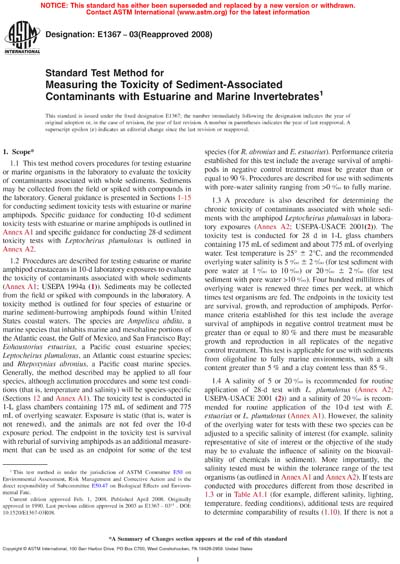Historical
ASTM E1367-03(2008)
Standard Test Method for Measuring the Toxicity of Sediment-Associated Contaminants with Estuarine and Marine Invertebrates
1.1 This test method covers procedures for testing estuarine or marine organisms in the laboratory to evaluate the toxicity of contaminants associated with whole sediments. Sediments may be collected from the field or spiked with compounds in the laboratory. General guidance is presented in Sections 1-15 for conducting sediment toxicity tests with estuarine or marine amphipods. Specific guidance for conducting 10-d sediment toxicity tests with estuarine or marine amphipods is outlined in Annex A1 and specific guidance for conducting 28-d sediment toxicity tests with Leptocheirus plumulosus is outlined in Annex A2.
1.2 Procedures are described for testing estuarine or marine amphipod crustaceans in 10-d laboratory exposures to evaluate the toxicity of contaminants associated with whole sediments (Annex A1; USEPA 1994a (1)). Sediments may be collected from the field or spiked with compounds in the laboratory. A toxicity method is outlined for four species of estuarine or marine sediment-burrowing amphipods found within United States coastal waters. The species are Ampelisca abdita, a marine species that inhabits marine and mesohaline portions of the Atlantic coast, the Gulf of Mexico, and San Francisco Bay; Eohaustorius estuarius, a Pacific coast estuarine species; Leptocheirus plumulosus, an Atlantic coast estuarine species; and Rhepoxynius abronius, a Pacific coast marine species. Generally, the method described may be applied to all four species, although acclimation procedures and some test conditions (that is, temperature and salinity) will be species-specific (Sections 12 and Annex A1). The toxicity test is conducted in 1-L glass chambers containing 175 mL of sediment and 775 mL of overlying seawater. Exposure is static (that is, water is not renewed), and the animals are not fed over the 10-d exposure period. The endpoint in the toxicity test is survival with reburial of surviving amphipods as an additional measurement that can be used as an endpoint for some of the test species (for R. abronius and E. estuarius). Performance criteria established for this test include the average survival of amphipods in negative control treatment must be greater than or equal to 90 %. Procedures are described for use with sediments with pore-water salinity ranging from >0 o/ooto fully marine.
ASTM International [astm]

